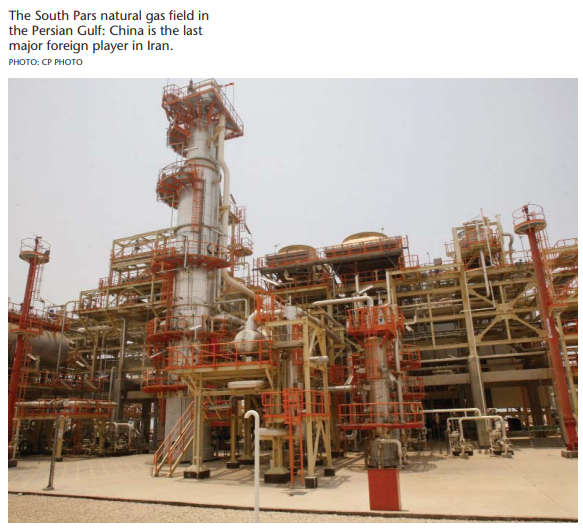
The $15.1-billion bid for Nexen Inc. by the China National Offshore Oil Corporation (CNOOC) has triggered a debate in Canada about how far to go in allowing China’s national oil companies (NOCs) to buy into the strategic oil and gas sector. The deal has also aroused some concern in the United States, where Nexen has a tiny proportion of its assets and a few critics have raised the issue of the national security implications of allowing the Chinese to gain an operating toehold in the energy sector.
But those risks and the anti-Chinese rhetoric that has seeped into the presidential campaign obscure an important strategic benefit to the current and any future administration: allowing China’s NOCs into North America provides them with a powerful incentive to stop doing business with Iran.
How to handle Iran’s opaque nuclear program is one of the most urgent and vexing questions facing Washington and its allies. The Obama administration sees squeezing the Iranian regime through sanctions as the best hope for curbing Tehran’s nuclear ambitions short of military strikes. The stakes are also high for Ottawa, which has taken an increasingly hard line on the issue.
Over the past decade, the US-led international sanctions regime against Iran has tightened. The United States has gradually ratcheted up the pressure through the implementation of increasingly robust sanctions on Iran’s energy, shipping and financial industries. These sanctions prescribe penalties for entities that engage in activities such as investing in Iran’s oil industry, selling gasoline to Iran or doing business with the Central Bank of Iran, the clearing house for oil payments. Australia, Canada, Japan, Norway and South Korea and the European Union have also implemented curbs on investment in Iran. The EU has also imposed an oil embargo against Iran and banned insurers and reinsurers from covering tankers carrying Iranian crude.
Meanwhile, China has emerged as the linchpin of the international sanctions regime against Iran. Although Beijing has no desire to see Iran acquire a nuclear weapons capability, it regards sanctions, especially unilateral ones, as an ineffective tool. Consequently, China’s NOCs are the only major foreign investors left in the Iranian oil patch. They remain occasional sellers of gasoline to Iran and large buyers of Iranian crude oil.
The arrival of China’s NOCs in the United States provides Washington with greater leverage over how these companies act in Iran. Put simply, the more China’s NOCs are invested in the United States, the more likely they are to curb their oil and gas business with Iran. Chinese oil executives are acutely aware that getting on the wrong side of politics in Washington can scuttle a deal, as witnessed by the furor that erupted on Capitol Hill over CNOOC’s ultimately failed 2005 attempt to acquire Unocal. Moreover, any proposed acquisition by a Chinese NOC that would result in Chinese control or ownership of oil or natural gas assets in the United States will undoubtedly end up being reviewed by the Committee on Foreign Investment in the United States (CFIUS) for national security risks. CFIUS is sure to assess the nature of the acquirer’s activities in Iran, among other issues.
And it is clear that the Chinese see North America as the preferred theatre for asset purchases. Over the past four years, North America has emerged as the new geographic focus of Chinese NOCs’ international mergers and acquisitions. China’s oil majors invested $3.4 billion in the United States and $10.9 billion in Canada between 2009 and 2011. So far this year, North America accounts for 95 percent of the $23 billion worth of global upstream investments made by China’s NOCs, including CNOOC’s proposed takeover of Nexen.
North America is attractive to China’s NOCs for a variety of reasons. First, China’s oil majors, like other oil companies, need to grow reserves and production, and North America is now the epicentre of upstream mergers and acquisitions thanks to the boom in unconventional oil and natural gas production. In 2011, 60 percent of the deals worldwide were in Canada and the United States. Second, China’s NOCs are eager to gain technological and operational expertise to develop China’s shale gas resources, which, on paper, are considerable. The US Energy Information Administration estimates that China’s technically recoverable shale gas resources are 50 percent greater than those of the United States. China’s NOCs, however, currently lack the know-how to exploit these resources.
Third, China’s oil majors are seeking to diversify political risk. The turmoil in the Middle East and North Africa over the past two years has prompted China’s NOCs to look for investment opportunities in more stable parts of the world.
CNOOC’s proposed takeover of Nexen, if successful, would represent a new step in China’s involvement in the North American energy sector. It would give a Chinese NOC an operating role in the United States for the first time, a development that could still trigger concern among some American lawmakers. CNOOC’s unsuccessful bid for Unocal sparked strong bipartisan opposition on the grounds that Chinese control of US oil and natural gas assets would be a national security risk, despite the fact that Unocal controlled less than 0.5 percent of American oil production. Although the response of US lawmakers to CNOOC’s announced acquisition of Nexen has been much more muted, at least one member of Congress has voiced national securityconcernsaboutChinesecontrol, even though Nexen’s share of US oil production is less than 0.1 percent. (Indeed, despite the North American tinge to the debate, almost 85 percent of Nexen’s net assets lie outside the continent.)
Meanwhile the expansion of the Chinese NOC footprint in the United States has coincided with the shrinking of their presence in Iran. CNOOC has pulled out of a $16-billion project to develop Iran’s North Pars natural gas field. The Iranians have frozen a $4.7-billion contract held by China National Petroleum Corporation (CNPC) for the development of Phase 11 of the South Pars natural gas field because of CNPC’s failure to start work. Sinopec is behind schedule in developing the Yadavaran oil field. Nor have China’s NOCs “backfilled” projects abandoned by European and Japanese oil companies after their home governments implemented tighter unilateral sanctions against Iran in 2010 and the Obama administration indicated that taking over such projects was a red line not to be crossed.
It would be more than diplomatically awkward for Washington to lean on China over its projects in Iran and then block its attempts to compensate for the loss of those opportunities by investing in North America. While the Chinese oil majors’ waning enthusiasm for Iran is partially due to the country’s difficult operating and investment climate, it almost certainly reflects their ambitions to expand here.
One way for Washington — and Ottawa — to spur China’s NOCs to continue their retreat from Iran is to continue to welcome them into North America, not only as passive investors but also as owners. Rolling out the red carpet for China’s NOCs would not only generate much-needed capital for the development of North American oil and natural gas resources, but it may also pay the geopolitical dividend of increased Chinese compliance on the issue of Iran. The road to curbing Iran’s nuclear program may run through the headquarters of CNOOC, CNPC and Sinopec.
Photo: Shutterstock by maoyunping








